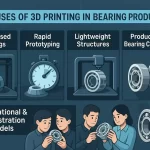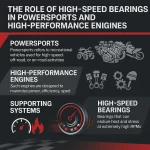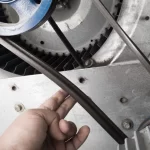Do you know what “bearings,” a mechanical component, actually do? They are so essential to the machine sector that they have been dubbed the sector’s “bread and butter.” They are employed in a wide variety of machines. Still, because they operate in secrecy, most individuals not engaged in the machine sector probably have no idea what they mean when they hear the name.
Bearings come in a wide range of shapes and sizes and are an essential tribological part of many different types of machinery. In a system that may be under static or dynamic loading, they can be described as a machine element that supports/permits only a particular form of motion (limitation of degrees of freedom).
What are bearings?
Bearings are “components that aid in the rotation of objects.” Inside the equipment, they support the shaft that revolves.
Automobiles, aircraft, power generators, and other devices need bearings. Even common household items like refrigerators, vacuum cleaners, and air conditioners we use daily contain them.
The rotating shafts of the wheels, gears, turbines, rotors, etc., in those devices, are supported by bearings, enabling smoother rotation. Although bearings in industrial applications may appear straightforward mechanical components initially, they are essential to our survival.
Purpose of Bearings
Bearings primarily avoid direct metal-to-metal contact between two elements in relative motion. By doing this, friction, heat production, and, ultimately, part wear and tear are avoided. As low-friction rolling takes the place of sliding motion, it also lowers energy consumption.
Additionally, they transfer the rotating element’s load to the housing. This load could be either radial, axial, or both. A bearing, as previously mentioned, limits the freedom of motion of moving parts in specific directions.
Different Types of Bearings
There are various types of bearings, each used for a particular function and designed to support a specific type of load, like ball bearings.
Ball Bearings
A ball bearing is a specific kind of rolling-element bearing that uses balls to keep the bearings’ inner and outer moving components apart. A ball bearing’s main functions are to support radial and axial loads and lessen rotational friction. Ball bearings in industrial applications have a straightforward design, are reliable, and are simple to maintain. They come in open and sealed varieties and single and multiple-row styles. They are appropriate for high speeds since they have low frictional torque.
Ball bearings connect the shaft to the motor housing, for instance, in electrical motors when the shaft is free to rotate but the motor housing is not. They are further divided into
Applications of the ball bearings:
- Household items: Bicycles, Washing machines, Hair dryers, Fishing rods, DVD players, and Food processors.
- Office equipment: Fax machines, hard drives, fans, etc.
- Industries: Elevators, assembly lines, Chain saws, power pumps, toy manufacturing, etc.
- Automotives: Engines, steerings, electric motors, gearboxes, etc.
Advantages of ball bearings:
- Do not require much lubrication.
- Long service life.
- Low price.
- Can handle thrust hold.
- Good wear resistance.
Disadvantages of ball bearings:
- Can break easily due to shock
- Can be loud
- Fail to handle heavyweight
Cylindrical Roller Bearing
The outer ring, inner ring, and cylindrical roller bearing roller all have a straight geometry. The cage may be made of brass, steel, or polyamide. You can separate the outer and inner rings. As the roller makes line contact with the raceway, these bearings can support significant radial loads. The bearings come in a variety of styles and dimensions.
Types of cylindrical roller bearing
- Single row
- Double row
- Four rows
- Full Complement
- Thrust cylindrical roller
Application of cylinder roller bearings:
- Mining,
- petroleum production,
- rubber mixing equipment,
- electric motors,
- rolling machines, etc.
Advantages of cylindrical roller bearings:
- They offer excellent stiffness
- These bearings can face challenges of heavy radials and high speed.
- It comes in split and sealed variants
- Low friction
- Long service duration
Disadvantages of cylindrical roller bearings:
- Not suitable for thrust loads
- When the inner or outer rings have two ribs, cylindrical roller bearings can withstand some axial load in one direction.
- Double-row cylindrical roller bearings are utilized largely in precision machine tools and have high radial stiffness.
Tapered Roller Bearings
In general, taper roller bearings application can be mounted independently from the cup because the cone assembly, which consists of the inner ring with roller and cage, is removable (outer ring). Mounting is made simpler by being detachable. The appropriate rolling motion of the roller on the track surfaces of the cone and cup is ensured by the projection lines of all the taper surfaces (Cup, Cone, and Roller) meeting at a single point on the bearing axis, known as the apex point. Single and double-row taper roller bearing applications in inch and metric series are produced by NBC.
Types of Tapered Roller Bearings
- Single row
- Double row
- Four rows
- Tapered roll thrust
Application of Tapered Roller Bearings
- Agriculture
- construction & mining industries
- sports robot combat
- propeller shaft
- engine motors and reducers
- wind turbines etc.
Advantages of Tapered Roller Bearings
- Low friction
- Long service life
- Rigid bearing applications
- Separable and interchangeable
- Enhanced operational reliability
Disadvantages of Tapered Roller Bearings
- Not suitable for high engine speed.
- Increase heat due to large contact surfaces.
Spherical Roller Bearings
In general, spherical roller bearings in industrial applications are designed for high radial loads. They automatically make up for significant angular faults (shaft misalignments). They typically have a two-row arrangement, with shared spherical raceways in the outer ring between both rows of rollers.
Types of Spherical Roller Bearings
- Spherical rollers.
- Spherical roller thrust bearings.
Application of Spherical Roller Bearings
- Industrial gearboxes
- conveyors
- cement grinding rolls
- passenger coach axle boxes of railways.
Advantages of Spherical Roller Bearings
- High load-carrying capacities
- Low friction
- Self-aligning
- Reduce noise and vibration levels
- Extended service life
Disadvantages of Spherical Roller Bearings
- Lower limit speed
- Poor heat dissipation with compound material
- Relatively high starting friction
Needle Roller Bearings
Typically, needle rollers and cages make up needle roller bearings. To facilitate flawless rolling action, several needle rollers are put between two hardened, smooth surfaces, and a cage prevents the needle rollers from touching one another. Needle roller bearings have relatively tiny roll bearing application diameters and great length-to-diameter ratios, which increases load-carrying capacity and makes them perfect for oscillation motion.
Types of Needle Roller Bearings
- Needle roller and cage assembly
- Shell-type needle roller bearings
- Machined ring needle roller bearings
- Thrust needle roller bearing
Application of Needle Roller Bearings
- Industrial gearboxes
- conveyors
- cement grinding rolls
- passenger coach axle boxes of railways.
- Rocker Arm Pivot
- Pumps
- Gearboxes
- Two or More Stroke engines, etc.
Advantages of Needle Roller Bearings
- Convenient at high and low temperatures
- Easy lubrication
- International standards and specifications are uniform.
- Easy to get interchangeable products
- Fewer friction
Disadvantages of Needle Roller Bearings
- Loud noise
- Complex structure
- Fatigue.
Conclusion:
We don’t frequently see these products immediately in our daily lives, such as machines that produce energy, materials, or machining equipment.However, as we’ve mentioned in this blog, a lot of bearings in industrial applications.These bearing applications help our daily life in addition to the force and rotation.Additionally, the functionality required of bearings is growing, and bearings suitable for many applications are in high demand. NBC, the leading bearing manufacturer, is acknowledged for its excellent quality and delivery.



















